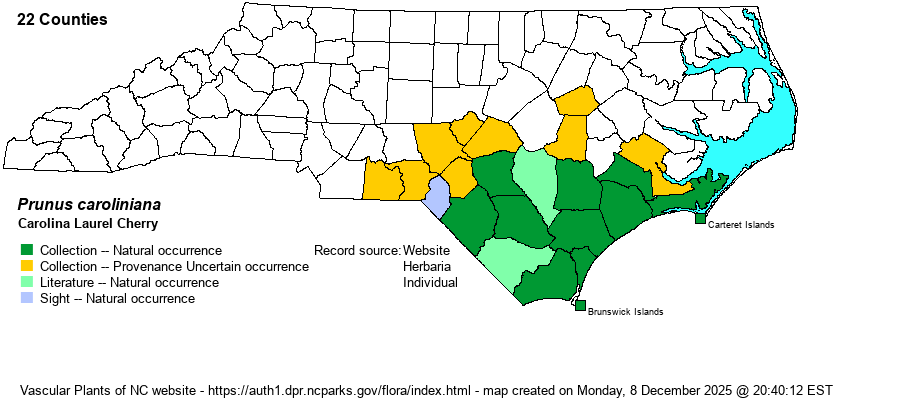| Author | (P. Miller) Aiton | |
| Distribution | Restricted as a presumed native species to the southern Coastal Plain, north to southernmost Scotland and Cumberland counties (probably) and Jones County (certainly). This species is known to readily escape, and its native range in the state -– especially away from coastal counties -- and globally is speculative as a result. Thought to be essentially a maritime forest/thicket species in NC and thus the native range might have been limited to coastal counties. There are numerous specimens and iNaturalist photos that are not mapped, as either they cannot be confirmed by the website editors, or the naturalness of the location cannot be established. Even some of the counties where mapped in green as "Natural Occurrence" might be better mapped in orange as Provenance Uncertain, though almost certainly it is native to the southern coastal counties. All records from the Sandhills proper are of escaped/established plants.
This Southern species ranges north only to southeastern NC, southern TN, and northern TX; it ranges to the Gulf Coast and southern FL.
| |
| Abundance | Common in maritime portions of southern coastal counties, and locally numerous farther inland in the southern Coastal Plain (where not certain if native) and in the Sandhills (all non-native). Accidental in the Piedmont, where certainly not native; farther north in the Coastal Plain, probably not native. | |
| Habitat | This species is native to maritime forests and thickets, primarily on coastal islands, in the state. However, it has escaped to various woodlots and thickets farther inland. |
| Phenology | Flowers from February to April, and fruits in September and October. | |
| Identification | This is a small to medium evergreen tree, rarely a large tree. In NC, at the northern edge of the range, it is mostly a small tree, growing to about 20-30 feet tall. The leaves are typically narrowly elliptic and similar to those of Black Cherry (P. serotina), averaging about 3 inches long. However, they tend to be a bit thicker and shinier (as would be expected for an evergreen species) and may be slightly more serrated along the margins. The inflorescence of small white flowers is shorter than on Black Cherry and is closer to the stem rather than spreading or drooping. However, one may have trouble separating the species from Black Cherry except in winter, when the latter has dropped its leaves. It is familiar to biologists working in southern coastal counties, though there is often the issue of determining if the species is native where seen, at least more than several miles from the coast. | |
| Taxonomic Comments | None
| |
| Other Common Name(s) | The “Laurel Cherry” part of the common name is often written as a single word or hyphenated. Carolina Cherry is an understandable alternate name. Confusingly, it is also often called Carolina Cherry-laurel or just Cherry-laurel. However, laurels are generally thought of as being shrubs in the Family Ericaceae, or members of the Laurel family (Lauraceae), such as Persea, Sassafras, and Lindera. Thus “Cherry-laurel” should be avoided and disused. | |
| State Rank | S3 | |
| Global Rank | G5 | |
| State Status | | |
| US Status | | |
| USACE-agcp | FACU link |
| USACE-emp | FACU link |

